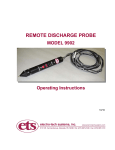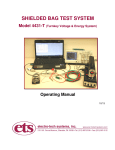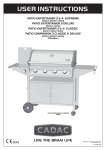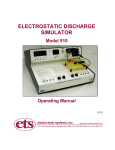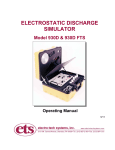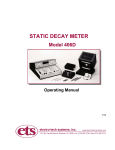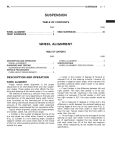Download PLUNGER PUMP SERVICE MANUAL MODEL - 1951 - Three-Es
Transcript
PLUNGER PUMP SERVICE MANUAL MODEL - 1951 DESCRIPTIVE ABBREVIATIONS: BSH = BOLT SOCKET HEAD BUR = BACK-UP-RING L.P =LOW PRESSURE H.P = HIGH PRESSURE SERVICING OF VALVE ASSEMBLIES REMOVAL OF VALVE ASSEMBLIES. Valve assemblies may be serviced without the need to remove the head or upset pipe work. The Inlet Valves can be accessed from the front of the block, and the Discharge Valves are accessed from underneath the block. If it is not possible to access these areas of the block, or if a complete service is required; the entire block may be removed from the drive-end - see ‘Removal of Manifold Block’ (page 2). 1. Using an M27 socket or spanner, loosen and remove the Valve Plug. 2. With a pair of pliers grip on the plastic tab at the top of the valve assembly / Spring Retainer. Pull the assembly from its Manifold housing. 3. To separate the valve assembly, insert a lever or screwdriver through the Spring Retainer and press on the back of the valve - the Retainer should release from the Seat. If the assembly separates and the Valve Seat remains in the manifold proceed as follows: a. Insert reverse pliers (part - 30696) into the Seat opening and gently pull from the Manifold. 4. Account for the Valve Seat O-Ring which may be stuck in the Manifold. 5. Remove the Seal Washer which will be located either in the Manifold - just bellow the plug thread, or located on the front of the valve plug. INSPECTION AND SERVICING OF VALVE ASSEMBLY. With the valve assembly disassembled the following parts will be available for inspection: Valve, Seat, Spring, Retainer, O-Ring, and Seal Washer. 6. Inspect the Springs for fatigue breaks and replace as needed. 7. Inspect the Valves and Seats for damage pitting or wear that could impede there function. Replace as needed. We strongly advise that O-Rings for broken down assemblies be replaced as a matter of course. Re-use of O-Rings is done so at the users risk. 9. Examine O-Ring sealing surfaces of the Valve Seat and corresponding manifold bore. check for scoring and wear that could impede the sealing or fit of corresponding O-Rings and parts. Replace as needed. A standard service kit will include the following parts: 3 x O-Ring, Valve Seat 3 x Retainer, Spring 3 x Spring, Valve 3 x Valve 3 x Seat, Valve 3 x Seal Washer, Valve Plug If replacement of all above parts is not planned, it is suggested that the o-rings and seal washers are replaced regardless. RE-ASSEMBLY OF VALVES ASSEMBLIES 10. Place the Valve onto its mating face of the Seat (dish side down). 11. Place the Valve Spring over its corresponding boss on the Valve. 12. Press the Valve Spring Retainer over the Spring and push to snap onto the Seat. 13. Press the new Valve Seat O-Ring into position onto the shoulder of the Valve Seat. 14. lightly lubricate the valve seat o-ring. 16. Repeat for all 3 valve assemblies. FITTING THE VALVE ASSEMBLY INTO THE MANIFOLD. Before re-assembly, ensure that all components are free of contaminants and water. If necessary blow off with an airline. 17. Push the valve assembly into its corresponding bore of the Manifold. Ensure the assembly is square to the bore when applying pressure to prevent snagging and damaging the O-Ring. For better control when carrying out this process; hold the Spring Retainer by its top tab using square nose pliers. 18. Ensure the assembly is held firmly and square in the bore. 19. Push the new Seal Washer into its location just beyond the female plug thread. To avoid damaging this PTFE seal, ensure it inserted squarely to the bore. 20. Insert and tighten each Valve Plug. Torque to 130 Nm. REMOVING THE MANIFOLD BLOCK The head can be removed without disturbing the pipe work 1. Loosen the M8 BSH screws with an Allen key tool. 2. The port flange rings slide along the flange pipe to allow the flange collar to be removed. 3. Apply light pressure to the flange sealing collar in order to overcome any O-Ring - face adhesion. 4. Loosen and remove the four M10 nuts connecting the Manifold Block to the Drive-end. Lightly tap the back of the Manifold Block to separate it from the Drive-end. Pull until the SERVICING OF SEALS To service the seals it is necessary to remove the manifold block - see section ’Removing the Manifold Block’ (page 2) 1. Using an M10 Allen key wrench; loosen and remove the two BSH screws from the back of the retaining plate. It is likely that in removing the L.P or H.P seal they will be damaged, and so any removed seals should be replaced. 2. With the Crankcase side of the manifold facing up, and the seal still housed in the manifold, try to inspect the condition of the LP seal. 3. Examine the L.P Seals for excessive wear to the internal sealing lip. Also inspect for any damage / irregularatories. Replace as needed. If deemed necessary to remove the L.P seal; try first by hand, otherwise use Internal Pliers (part 30696) located on the inside of the L.P seal. As a precaution try to grip towards the back of the seal where the section is thickest, and less likely to cause serious damage. 4. Pry the Low Pressure Seal Cases from the manifold using lever bars. This will expose the High Pressure Seals. 4. Inspect the H.P Seals as for Low Pressure Seal. SEAL INSPECTION. With the seal parts disassembled the following will be available for inspection: L.P seal (optional), H.P seal (optional), Seal Case O-Rings, Seal Case BUR, Seal Case, Manifold Block, Crankcase Insulating Gasket. 5. Examine the O-Rings and BUR’s, check for wear, damage, deteriation. Replace as needed. 6. Inspect the condition of the Crankcase Insulating Gasket. Check for damage and any deviation in shape or thickness in the Gasket. 7. Examine the metallic parts for damage, specifically wear and condition of o-ring and seal contact surfaces. Replace as needed. Consult with Cat Pumps if concerned as to condition of Manifold Block. The standard Seal Kit will include the following parts: 3 x BUR, Plunger Retainer 3 x O-ring, L.P Seal Case 3 x O-ring, Plunger Retainer 3 x BUR, L.P Seal Case 3 x L.P / H.P seal NOTE: The Plunger Retainer BUR’s and O-Rings are yet to be inspected, This will be covered in the next section. REASSEMBLE OF SEAL ASSEMBLIES AND ASSOCIATED PARTS. Assuming you are now satisfied with the condition of all parts. Place the manifold Block on the bench, Crankcase face up. Before re-assembly, ensure that all components are free of contaminants and water. If necessary blow off with an airline. 8. Press the HP seals into there bores, sprung end in first. Take extra care to ensure the seal is kept square to the bore at all times to avoid damaging the seal. 9. Take each L.P seal case, apply the BUR, and then the O-Ring into its appropriate groove (NOT the first groove which contains fluid vent holes). 10. Lightly lubricate the O-Rings and insert the L.P Seal cases into there bores. 11. Press the L.P seal into its bore at the back of the Seal case. Apply the same technique as for the H.P seal. 12. Couple the Seal Retaining Plate onto the Manifold Block. 13. insert the two securing M10 BSH screws, tighten, and torque to 28Nm. SERVICING THE PLUNGER RETAINER SEALS. Disassembly With the Block Manifold removed [revert to page 2], Proceed as follows: 1. Loosen the Plunger Retainers 4-5 turns using a M24 hex socket. Push on the Plunger towards the Crankcase. The retainer should pop out of the plunger. 2. Remove the Plungers and Retainers. Note that the Retainer stud will remain either in the plunger rod or the plunger retainer - it is insignificant in which it continues to be housed. 3. Remove the Plunger Retainer O-Ring and BUR, inspect for damage and replace as necessary. Inspect the ceramic Plungers for damage (cracks and scoring), replace as needed. 4. Remove the Seal Retainers from over the Plungers. Check for moisture inside the cylinder - remove. Check that the drain pipe is still tightly secured on its hose tail, and is still sealed at the bottom end. Re-Assembly Before re-assembly, ensure that all components are free of contaminants and water. If necessary blow off with an airline. 5. If the Plunger Retainer gasket has been removed, ensure it is replaced before the O-Ring and BUR. 6. Replace the O-Ring and BUR. The BUR is positioned on the inside / Stud side of the groove. 7. Remove loose thread adhesive with a clean cloth, or Airline 8. Replace the Barrier Slinger - concave side away from Crankcase, Keyhole Washer split facing down, and Collar spacer. 9. Apply Loctite 242 to the exposed end of Plunger Retainer Stud. 10. Next slide the Plunger onto the Plunger Rod. Do not force the Plunger, if it does not push all the way home (with the back of the Plunger in contact with Keyhole washer) then the plunger is oriented the wrong way. 11. Insert the Plunger Retainer into the front end of the Plunger, tighten onto the stud, and torque to 10Nm. 12. Push the Seal Retainer back over each Plunger - pipe end forward most. Ensure each is located in its Crankcase bore. 13. Ensure that the Gasket, Manifold (insulative) is located on the Guide Pins at the front of the Crankcase. 14. Carefully, and keeping square to avoid damaging seals and Plungers - push the Manifold over the Plungers, and position as close as possible towards the Crankcase. Locate onto the M10 studs and guide pins. 15. Tighten the M10 nuts, then Torque to 28Nm in accordance with the bellow sequence: 1 3 4 2 SERVICING OF CRANKCASE SECTION. 1. Whilst the head and Plungers are removed, it is a good idea to examine the Crankcase Seals for wear, material condition, and evidence of leakage. 2. Check the oil level and evidence of water or contaminants in the oil. 3. Rotate the Crankshaft by hand and sense for smooth running of the Bearings. 4. Consult with the Cat Pumps should the condition of the Drive-end necessitate a service. TORQUE CHART Item Description Thread Tool size Torque Plunger Retainer M7 M14 HEX 10Nm Head Nuts M10 M10 ALLEN 28Nm Retaining Plate HSH M10 M10 ALLEN 28Nm





